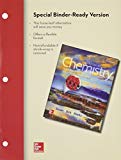
Concept explainers
Interpretation:
The total pressure of mixture of gas and partial pressure of argon gas and nitrogen gas in the tank at
Concept Introduction:
The number of moles
Where,
Dalton’s law of partial pressure states that the total pressure of the mixture of gases is equal to the sum of partial pressure of gases present in the mixture of gases.
Answer to Problem 132QP
Solution:
The partial pressure of argon gas and nitrogen gas in the tank are
Explanation of Solution
Given Information: The volume of the tank is
The tank contains a mixture of gases
The molar mass of
The moles of argon gas are
Convert temperature units from Celsius to Kelvin.
For
Substitute
Therefore, the partial pressure of argon gas in the tank is
Therefore, the partial pressure of nitrogen gas in the tank is
The total pressure of the mixture of gases in the tank is the sum of the partial pressure of argon gas and nitrogen gas according to Dalton’s law. Therefore, the total pressure of gases is,
Therefore, the total pressure of the mixture of gases in the tank is
The partial pressure of argon gas and nitrogen gas in the tank are
Want to see more full solutions like this?
Chapter 9 Solutions
Combo: Loose Leaf for Introduction to Chemistry with Connect Access Card Chemistry with LearnSmart 1 Semester Access Card
- A mixture at 33 °C contains H2at 325 torr. N;at 475 tore and O2at 650. torr. What is the total pressure of the gases in the system? Which gas contains the greatest number of moles?arrow_forwardA collapsed balloon is filled with He to a volume of 12.5 L at a pressure of 1.00 atm. Oxygen, O2, is then added so that the final volume of the balloon is 26 L with a total pressure of 1.00 atm. The temperature, which remains constant throughout, is 21.5 C. (a) What mass of He does the balloon contain? (b) What is the final partial pressure of He in the balloon? (c) What is the partial pressure of O2 in the balloon? (d) What is the mole fraction of each gas?arrow_forwardIf equal masses of O2 and N2 are placed in separate containers of equal volume at the same temperature, which of the following statements is true? If false, explain why it is false. (a) The pressure in the flask containing N2 is greater than that in the flask containing O2. (b) There are more molecules in the flask containing O2 than in the flask containing N2.arrow_forward
 Chemistry: The Molecular ScienceChemistryISBN:9781285199047Author:John W. Moore, Conrad L. StanitskiPublisher:Cengage Learning
Chemistry: The Molecular ScienceChemistryISBN:9781285199047Author:John W. Moore, Conrad L. StanitskiPublisher:Cengage Learning Introductory Chemistry: A FoundationChemistryISBN:9781285199030Author:Steven S. Zumdahl, Donald J. DeCostePublisher:Cengage Learning
Introductory Chemistry: A FoundationChemistryISBN:9781285199030Author:Steven S. Zumdahl, Donald J. DeCostePublisher:Cengage Learning Chemistry for Engineering StudentsChemistryISBN:9781337398909Author:Lawrence S. Brown, Tom HolmePublisher:Cengage Learning
Chemistry for Engineering StudentsChemistryISBN:9781337398909Author:Lawrence S. Brown, Tom HolmePublisher:Cengage Learning Chemistry: Principles and PracticeChemistryISBN:9780534420123Author:Daniel L. Reger, Scott R. Goode, David W. Ball, Edward MercerPublisher:Cengage Learning
Chemistry: Principles and PracticeChemistryISBN:9780534420123Author:Daniel L. Reger, Scott R. Goode, David W. Ball, Edward MercerPublisher:Cengage Learning Chemistry & Chemical ReactivityChemistryISBN:9781337399074Author:John C. Kotz, Paul M. Treichel, John Townsend, David TreichelPublisher:Cengage Learning
Chemistry & Chemical ReactivityChemistryISBN:9781337399074Author:John C. Kotz, Paul M. Treichel, John Townsend, David TreichelPublisher:Cengage Learning





